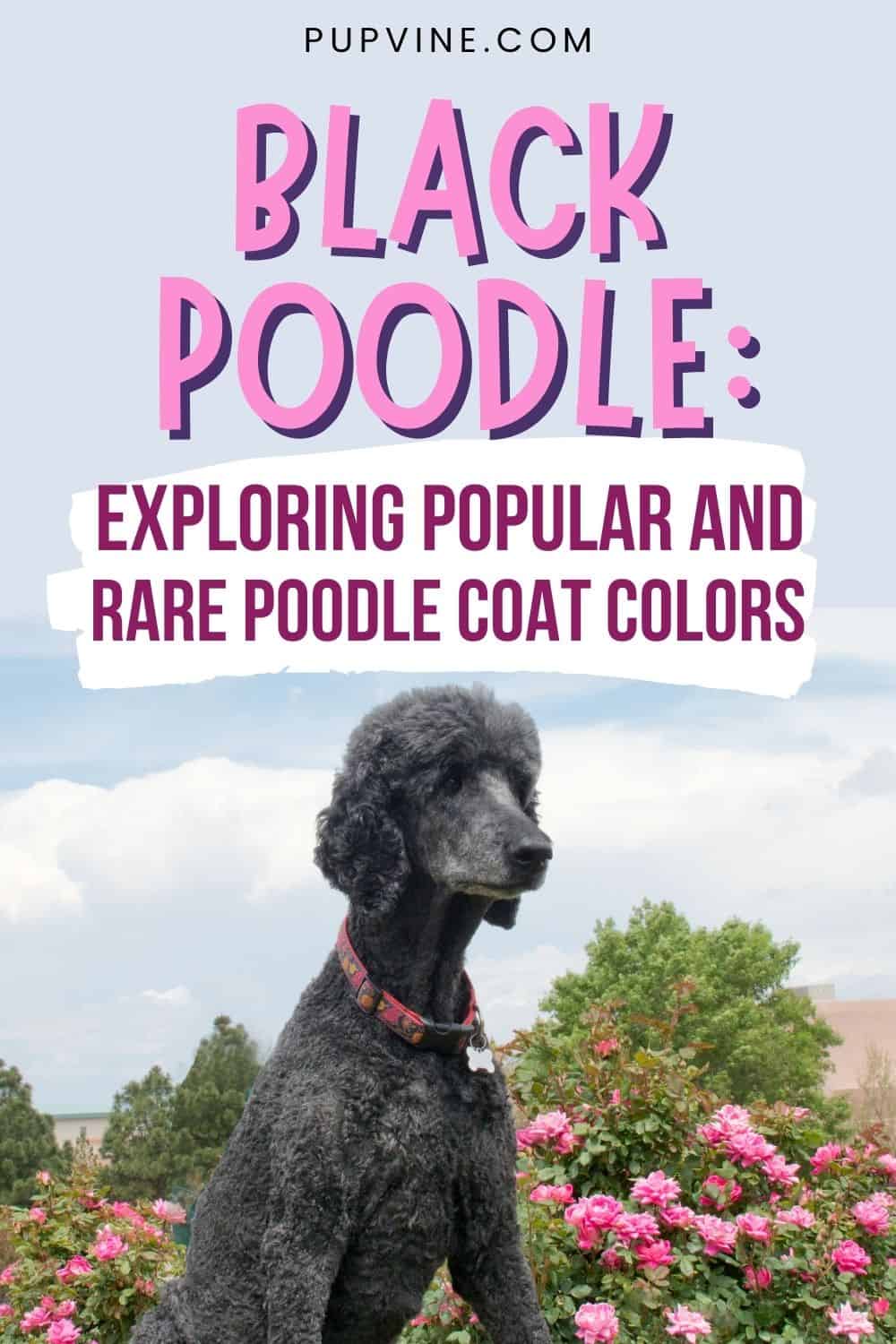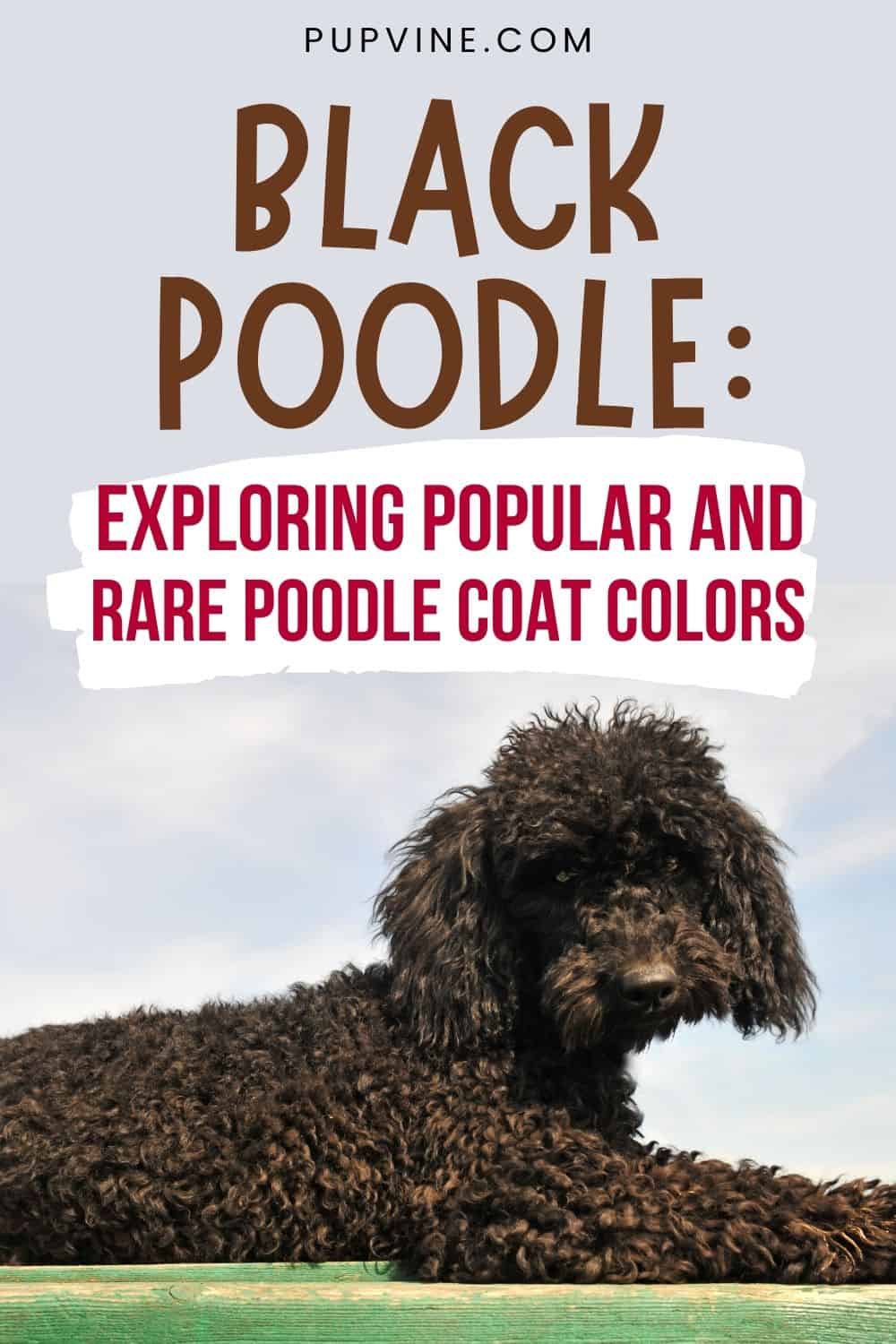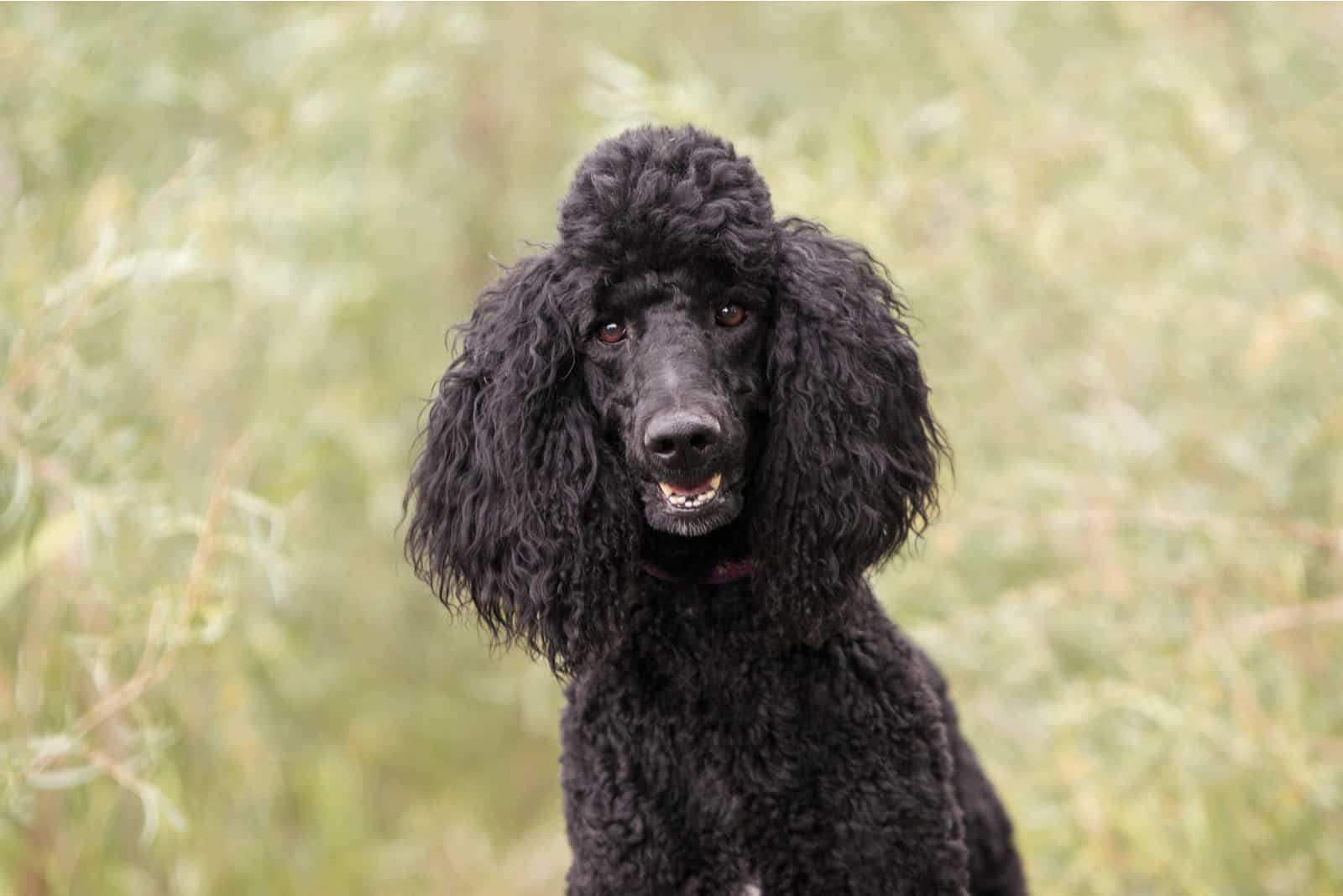The Poodle has been a favorite of dog lovers all over the world for many years. It consistently stays within the top ten most popular dog breeds everywhere and kept the number one spot in the USA for an astonishing 22 years, between 1960 and 1982. No other dog breed has ever broken this record!
So, what is it about Poodles that makes them so appealing? Does the coat color have anything to do with their popularity? It may surprise you to learn that black Poodles may appear to be more common, but they are not necessarily more popular. This is because the gene that causes the black coat is the most dominant, though many people prefer lighter-colored dogs.
Also, thousands of puppies are registered as being black but will not stay this color!
Black dog breeds sometimes have a tough time. It’s difficult to say exactly why this is, but the problem seems to have psychological roots. Experts speak of something called black dog syndrome, which is where people seem to have a negative attitude towards our furry friends with black coats, whatever the breed.
The evidence of this phenomenon can be seen in rescue centers and dog shelters, as black dogs generally make up the majority of the occupants. Some experts suggest it’s because humans have developed a subconscious assumption that black dogs are aggressive or difficult to live with because of behavioral problems.
Others point out that a more likely reason for this imbalance is that black dogs don’t show up so well in photographs or may be partially hidden in their stalls at the rescue centers, which is why people pass them by and pick dogs with a lighter-colored coat. Despite what you might read elsewhere, white Poodles are always the most popular choice.
Whatever the reason, it’s time to give black dogs and black Poodles, in particular, a well-deserved boost.
We’re going to take a look at all things Poodle-related and answer some of the more frequently asked questions, with the focus firmly on black Poodles.
But first, a little history lesson…
The French Poodle?
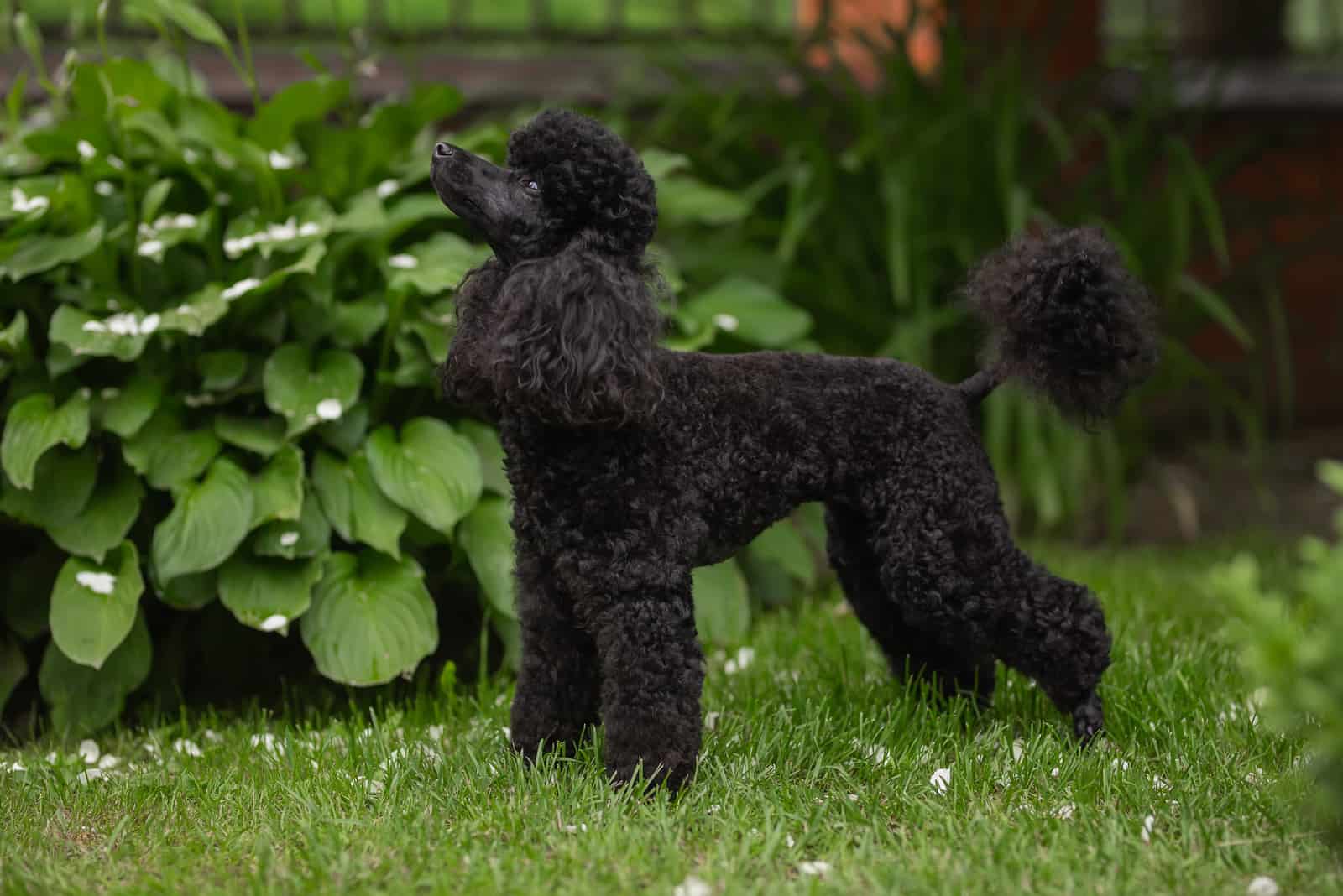
The Poodle has to be French, doesn’t it? After all, it’s the national dog of France and is often referred to as the French Poodle.
Actually, no!
Although they’ve been around in France since the 1500s, it’s widely thought that the Poodle breed is, in fact, from Germany. They’re not even known as Poodles in France. Instead, they’re called Caniche, which basically means duck dog, a reference to their use in duck hunting.
Popular culture (especially cartoons!) has a lot to answer for when it comes to fixing ideas in our brains. Poodles are often portrayed as being very French. They are featured wearing berets, speak with a French accent, have French owners, and there’s usually accordion music playing in the background.
However, most dog historians believe that the Poodle originated in Germany, a fact supported by its name, which is spelled Pudel in German. This comes from the root word Pudeln, meaning ‘to splash,’ a reference to their original use in hunting, where they retrieved shot birds from rivers and lakes.
To be fair to the French, they played a big part in developing the breed for a few hundred years, creating the wonderful Poodle dogs we see today.
They were bred to be smart, athletic, obedient, and sociable. Their coats were designed to protect them from the cold water, and the tufts on their legs provided more powerful strokes when swimming. Their hindquarters were usually shaved to reduce drag in the water.
Their athletic abilities and high intelligence made them ideal circus dogs, where they often accompanied clowns in the ring.
Thankfully, times changed. Hunting became less fashionable, and in more recent years, people realized that making animals perform to entertain us is cruel and demeaning. Poodles are now mostly kept as companions because of their family-friendly nature and athleticism.
Aside from the Standard Poodle, there are three further sizes: medium, miniature, and toy Poodles. However, the medium Poodle isn’t recognized in some countries.
But what about that coat? Does the color really matter? Let’s take an in-depth look at Poodle coat colors to find out!
What Coat Colors Do Poodles Have?
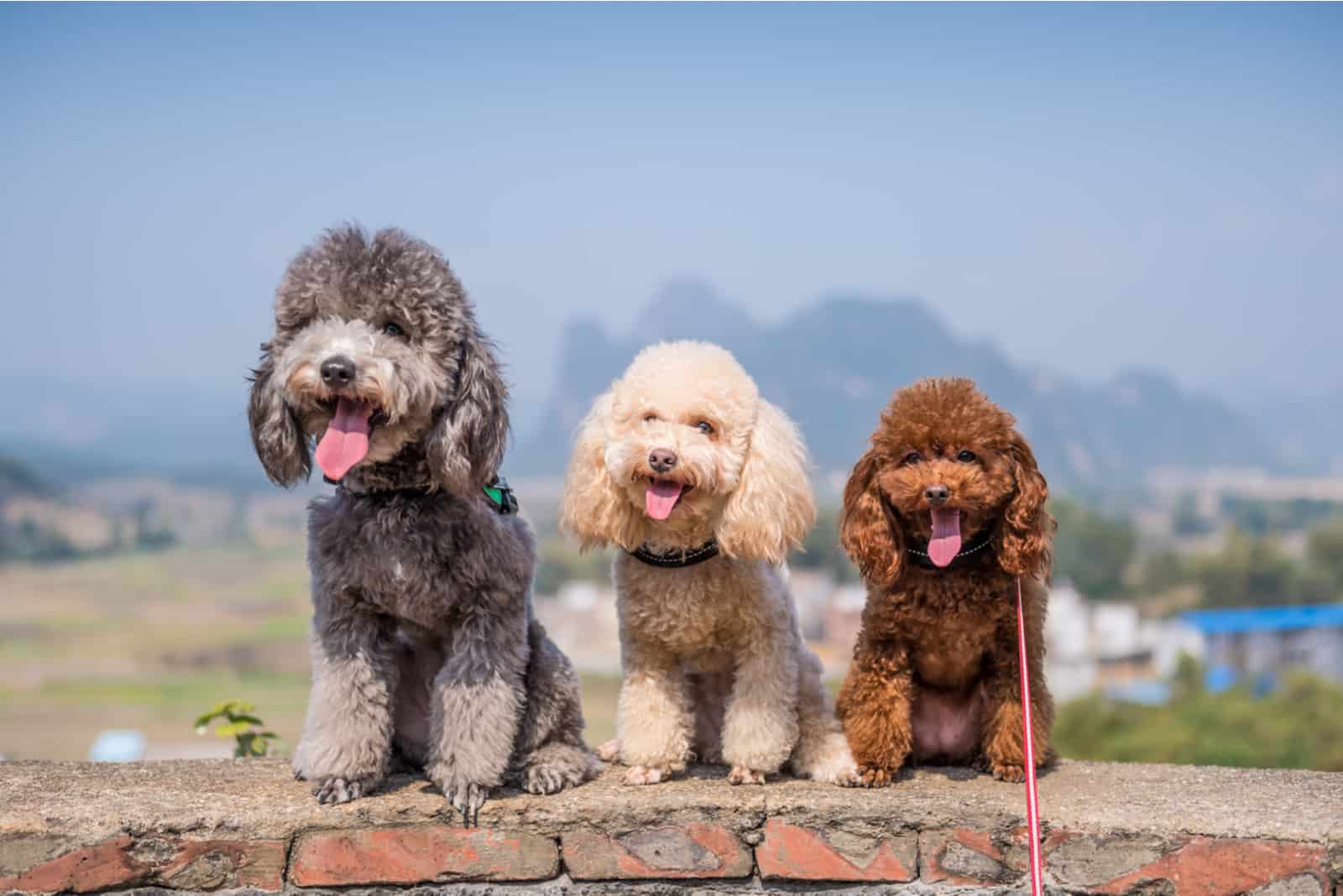
Originally, there were three colors: black, white, and brown. These were usually all solid colors, meaning that there were no other patches or markings.
Over the years, other solid colors have been added, including:
• Apricot
• Red
• Cream
• Cafe au lait
• Blue
• Gray
• Silver beige
• Silver
• Cream
Some are rarer than others, though white remains the most popular color at present.
In addition to these, there are Parti Poodles, which have a white base coat with a second color covering at least 50% of the dog. This second color can be anywhere on the dog, meaning that few Parti Poodles ever look alike.
The color and markings aren’t important unless you plan to put your dog into the show ring. The American Kennel Club (AKC) allows different colored Poodles to be registered, but they are disqualified from dog shows.
Of course, all of these colors are variations and mixes of each other, achieved by the clever use of dominant or recessive genes. Poodle breeders really know their subject, creating some stunning new hues in recent years.
What Is The Rarest Color Of Poodle?
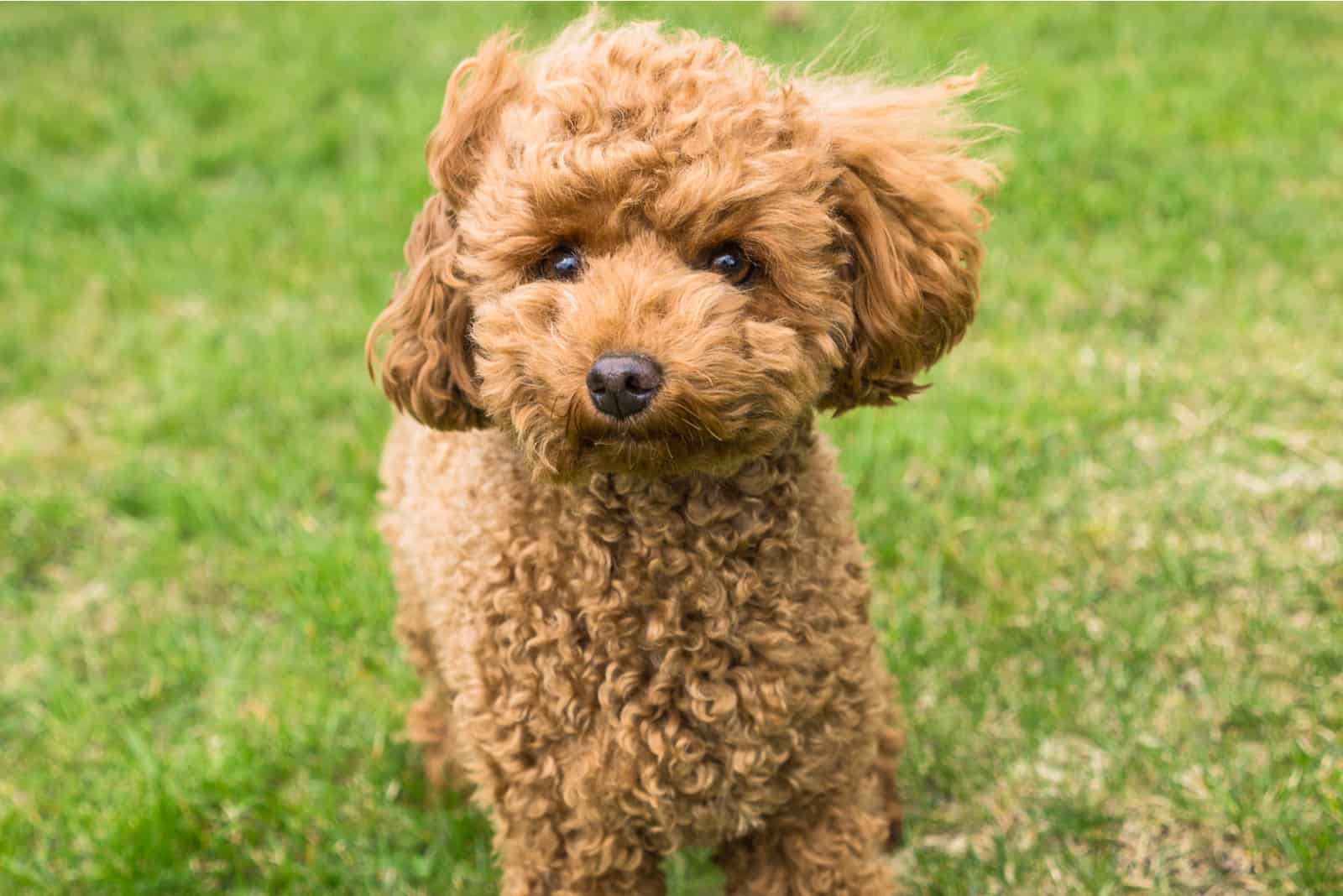
Apricot Poodles are the rarest of all, usually set against black points, meaning that their noses, toenails, eye rims, and lips will be black. They also have beautiful dark eyes, sometimes of a deep amber color.
They come in different tones, which often results in apricot being mistaken for red or even cream. This is no surprise, as the apricot color is a faded version of the red coat due to a recessive gene.
Most apricot Poodles will have a light orange topcoat with an undercoat of a faint cream color, though each individual dog may have a different hue.
If you have one of these cute dogs, consider yourself lucky! There are very few of them anywhere in the world, and they always turn heads when they appear at shows or in the street.
You can get apricot Poodles in all the usual sizes, but if you want one for yourself, you might have a wait on your hands.
What’s So Great About The Black Poodle?
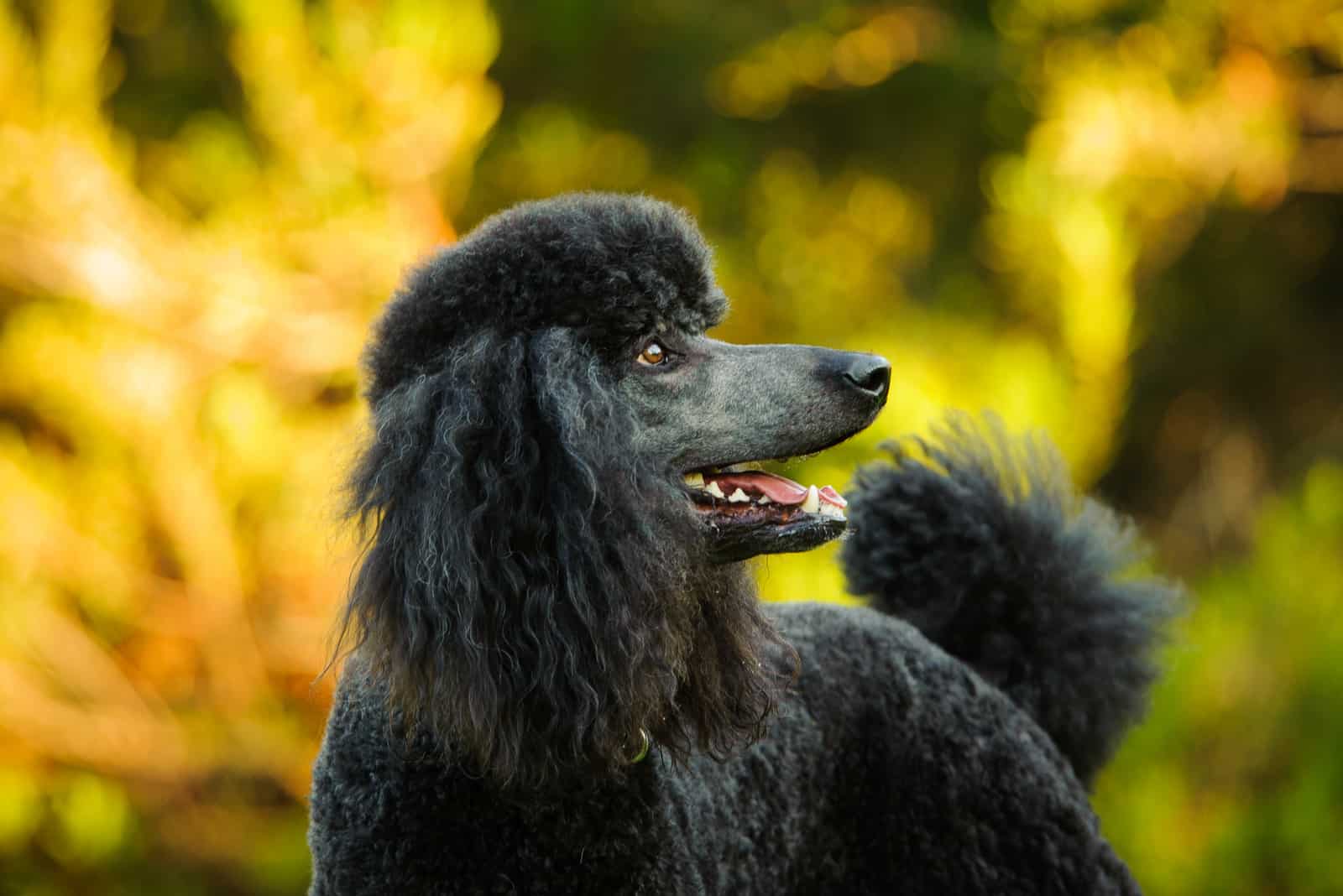
There’s something special about a black dog’s coat. The black Poodle is a favorite in the show ring with its black points (eyes, paw pads, lips, and nose). Beneath that dark fur, it will most likely have dark gray skin that complements its coat.
True black Poodles will hold their color rather than fade. They won’t have any other patches or tints and will keep their ink-black color throughout their lives.
It’s sometimes tricky to tell what color a pup will be when they are older, as the black coat ‘clears’ as the dog matures. We’ll cover this in more detail later, but for now, we’ll just say that blue
Poodles and silver Poodles start out black but will develop their true colors by the time they reach two years of age.
Despite this, they are all registered as being black at birth! As we saw at the start of our article, this artificially boosts the number of black Poodles, giving the impression that they are more popular.
In terms of temperament and character, black Poodles are no different from any other. Some Poodle owners might argue against this, claiming that one color displays better or worse qualities.
However, there is no scientific proof of this.
Are There Black And White Poodles?
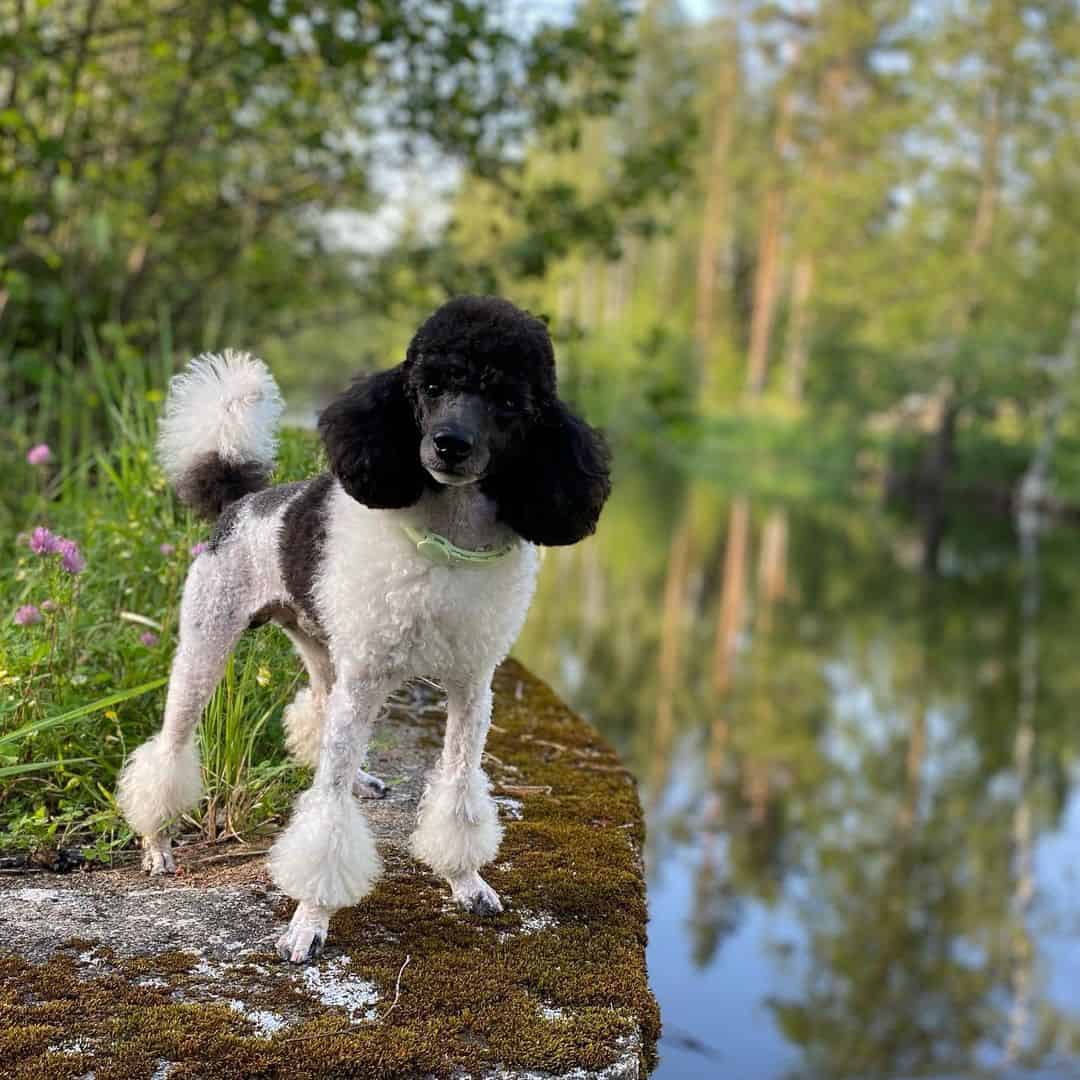
Photo from:@toyharlequinjallu
Yes! The Parti Poodle can have a two-tone black and white coat. Basically, they are a white dog, with 50% of their coat being black.
Each one is unique because the patches are irregular and randomly spaced across the body. With a Parti Poodle, you definitely have a one-of-a-kind!
Solid black and solid white are the most common Poodle colors, with other colors being added in recent years. However, the Parti Poodle is not a new innovation, as famous paintings exist that prove them to be at least 400 years old!
These two-tone beauties likely disappeared from the scene as fashions dictated that solid colors were more desirable. Rumors suggest that parti-colored pups were destroyed so that they couldn’t ‘pollute’ the gene pool.
Thankfully, this kind of unethical, backward thinking is rare these days, and the Parti Poodle is firmly back in the picture, although bodies like the AKC don’t recognize them in the Poodle breed standards.
There’s a certain amount of suspicion in some Poodle enthusiasts that somehow the Parti Poodle is not purebred. While it’s true that some types of Poodle mix, such as the Labradoodle, have the parti gene, the Parti Poodle is 100% purebred.
So, while you might not be able to enter them into dog shows (yet!), you can get yourself a black and white Poodle if you wish.
Do Poodles Have Black Skin?
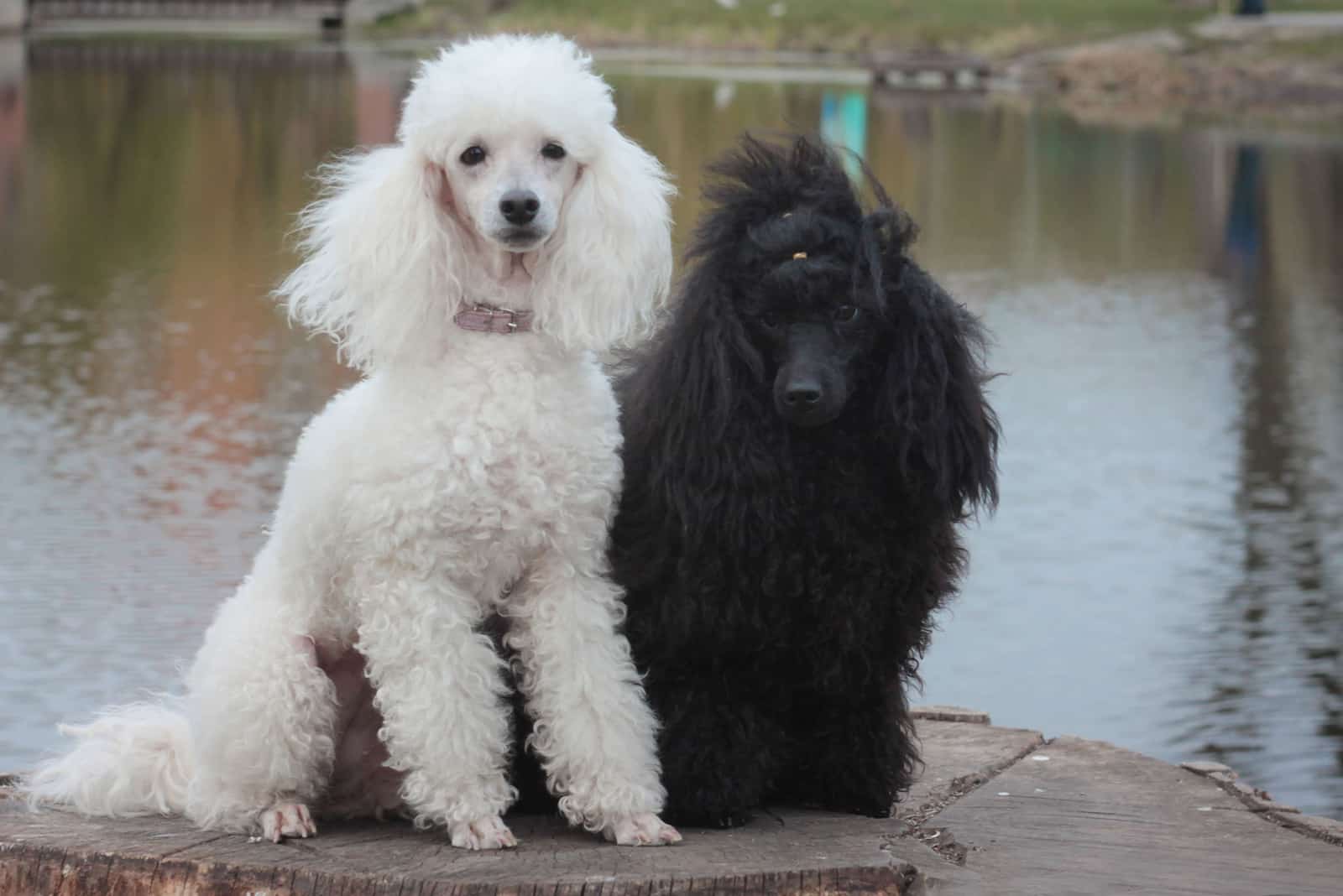
Some do, and some don’t. A black Poodle usually has dark gray skin, whereas blue Poodles might have a bluish tint to their skin.
The trouble is that the Poodle’s skin and coat color don’t always match! A white Poodle might have pink, silver-gray, or bluish-black skin. Other Poodles might have blue/black mottled or spotted skin.
The genes that control skin pigmentation are different from those that contribute to the coat color. Although mottling and spots don’t usually disqualify a dog from the show ring, they can sometimes affect the number of points the dog scores. However, some serious Poodle enthusiasts regard them as faults, preferring to see solid pigmentation.
Poodles often have more skin showing than other dogs because the coat is clipped in a variety of styles that expose it. Obviously, a solid block of color looks neater than a mottled skin, but this really comes down to personal preference and whether you plan to submit your dog to the critical eyes of dog show judges.
One note of concern is that skin exposed to sunlight will darken over time. Poodle owners need to exercise care, as sunburn is a real possibility. Even worse, the dog may be at risk of skin cancer.
Black Miniature Poodle
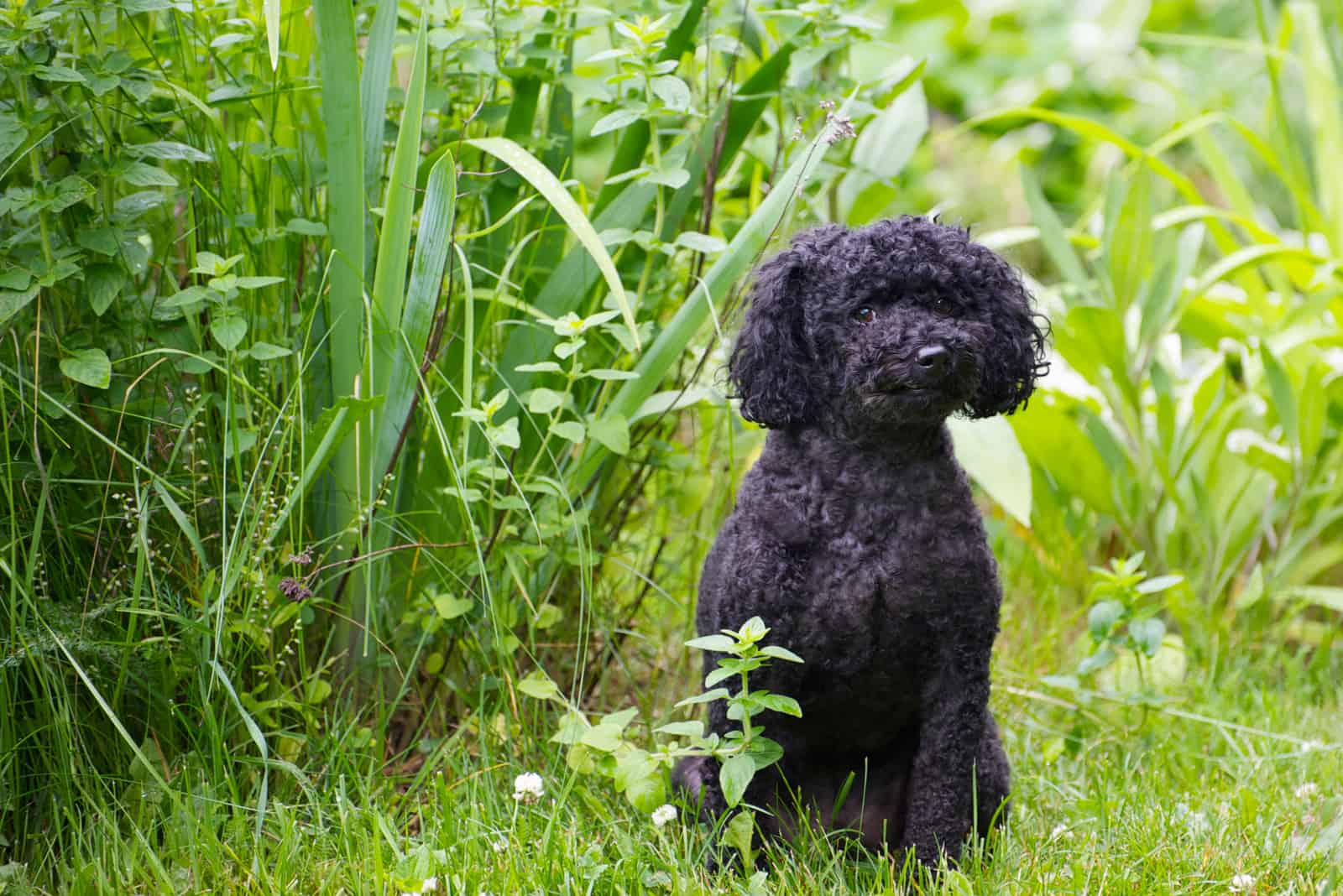
If there’s anything more adorable than a cute black Poodle of the standard variety, it’s a Mini Poodle in the same color!
Miniature Poodles measure 10 and 15 inches at the withers (shoulders) and, oddly enough, weigh between 10 and 15 pounds.
The great thing is that they keep all the admirable qualities of the larger dogs but are more suited to smaller properties and apartment living. Also, they won’t need feeding as much, which will help your budget for dog food.
Black Toy Poodle
As if the Mini Poodle isn’t small and cute enough, you can go smaller still with the Toy Poodle.
A black Toy Poodle Puppy is one of the cutest things you’ll see. Also in their favor is the fact that they are very easy to train. Their main mission in life is to be your best friend.
To qualify as a ‘toy,’ it must stand no taller than 10 inches and weigh between 4 and 6 pounds.
Of course, if you want to go smaller still, you could look for Teacup Poodle puppies, although these are really just undersized versions of the mini.
How Much Is A Black Toy Poodle?
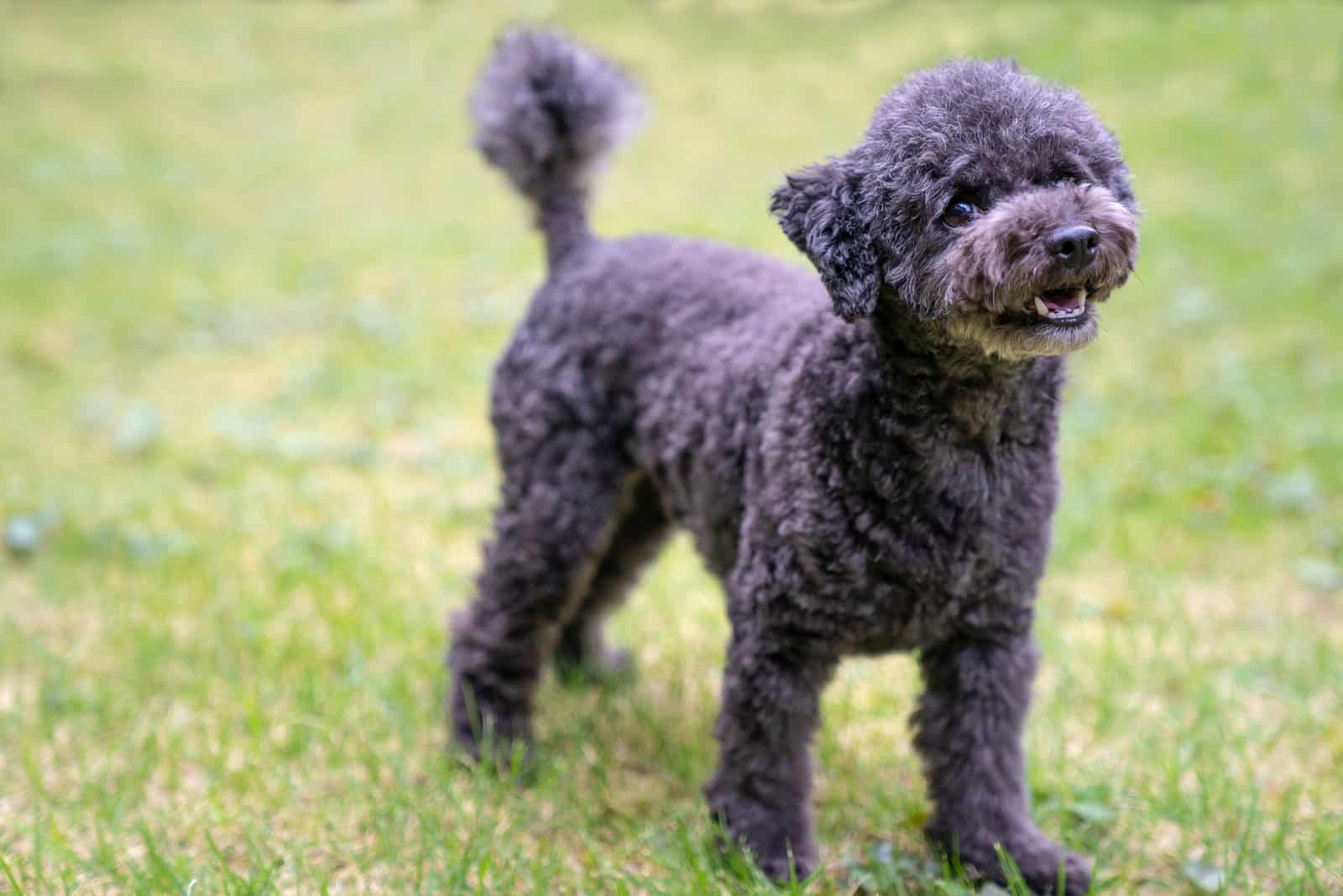
The average cost of a black Toy Poodle is somewhere between $1,200 and $2,000. The actual cost will depend on where you get your pup, and you have several choices when it comes to this.
You could approach an established Poodle breeder, a backyard breeder, or a puppy mill. Clearly, if you care about the health and welfare of your pup, you’ll avoid the last two sources! Reputable breeders generally follow high standards of ethics and will always be open and honest about their business.
Read Next: 10 Poodle Breeders In Virginia For A Curlier Life
Amateur breeders who are in it purely for the money will cut as many corners as possible to maximize profits. They have a reputation for providing inadequate accommodation for their dogs, poor-quality food, and failing to implement health screening or genetic testing. This leads to undernourished pups with a range of health conditions.
Bear in mind that reputable breeders often make a loss on some litters. The cost of a single pup might be high, but breeding pups is an expensive business when done properly!
Alternatively, you can always try to adopt from a shelter or rescue center, which will be significantly cheaper. You might have a long wait, though, as these pups rarely find their way to rescues and shelters, and when they do, they are usually snapped up pretty quickly.
Black Yorkie Poodle
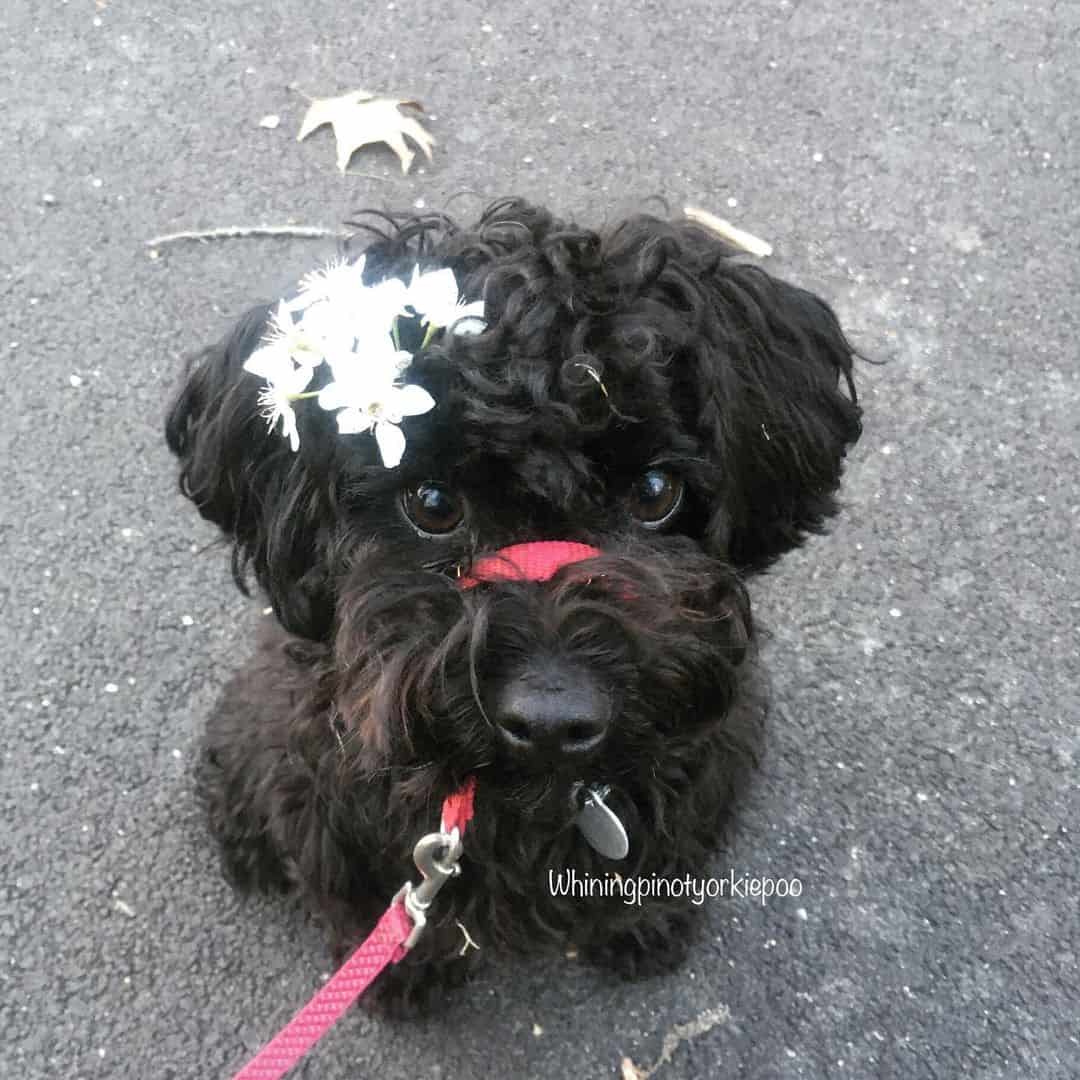
Photo from:whiningpinotyorkiepoo
These dogs just keep getting cuter!
If you love Yorkies, then a Yorkie Poo designer breed might be just the thing for you. And a black Yorkie Poodle is almost too adorable for words.
All of these toy, mini, or teacup dogs are great for modern living, especially in urban settings and apartment life. However, they are also suited to many other lifestyles because they are so small and portable.
With the combination of the Yorkie and Poodle character, you can be sure that they’ll be charming, obedient, affectionate, and exceptionally loyal.
They are kid-friendly and a good choice for first-time dog owners. They’re pretty easy to train, though they may show a tendency to bark at times, like all small dogs.
In terms of size, they weigh between 3 and 14 pounds and measure between 7 and 14 inches at the shoulder.
And finally, because of their Poodle genes, they are a great choice for allergy sufferers!
Can A White Poodle Have Black Puppies?
Yes, they can. While it doesn’t seem likely, two white dogs can have black puppies if they both carry the dominant black gene.
That’s the fun thing about genetics, as certain genes can stay hidden for generations before popping up unexpectedly.
Two Poodles of the same color can produce a litter of pups with a variety of colors. However, two black Poodles will never produce white pups.
Can A Black Poodle Have Red Puppies?
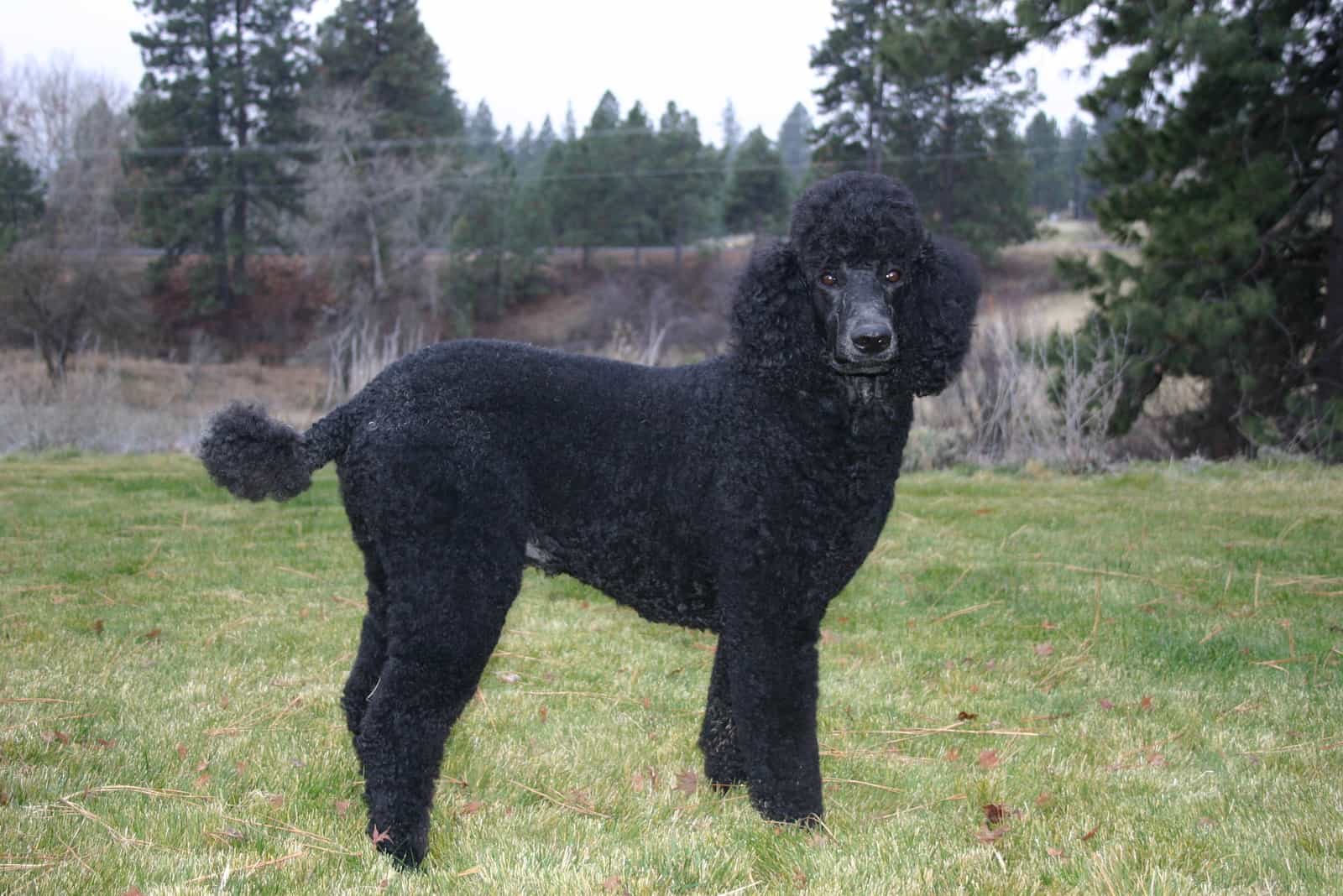
It’s possible. Red Poodles are a fairly new addition and were only accepted by the AKC in 1980.
For many years, it was thought that the red color was associated with the apricot coat. However, breeders and other experts now believe that a separate gene is responsible, which they have named the rufus gene.
Although the gene that causes black fur is dominant over all the others, a black Poodle can be bred with a red Poodle to produce red puppies. Breeders sometimes introduce a black Poodle into a red Poodle breeding program to help keep the points dark and to darken the red fur even further.
Black Poodle Puppy Turning Silver
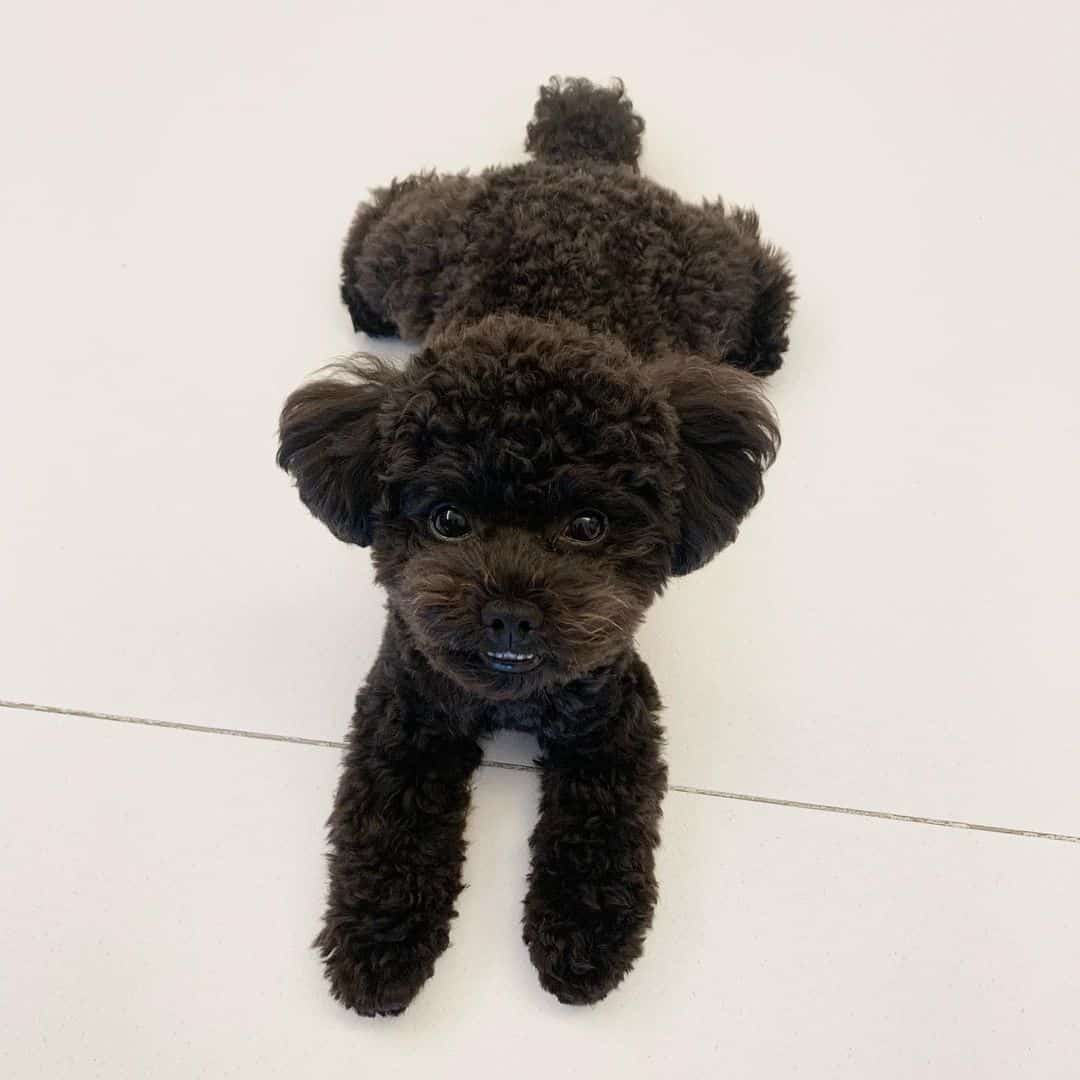
Photo from:@theminikingkong
It’s not unusual for a black puppy to turn silver. Once again, it’s all about the genes that determine coat color and which ones are more dominant in the parent dogs.
Silver Poodles are highly sought after but extremely difficult to find! Some dogs have the fading gene that changes the coat color as the dog ages. A black Poodle with this gene might gradually turn to blue or silver by the time they reach two years of age.
This is known as coat clearing and can happen to any Poodle.
If you really want a true black Poodle, you’ll need to rely on the expertise of the breeder.
Are Silver Toy Poodles Born Black?
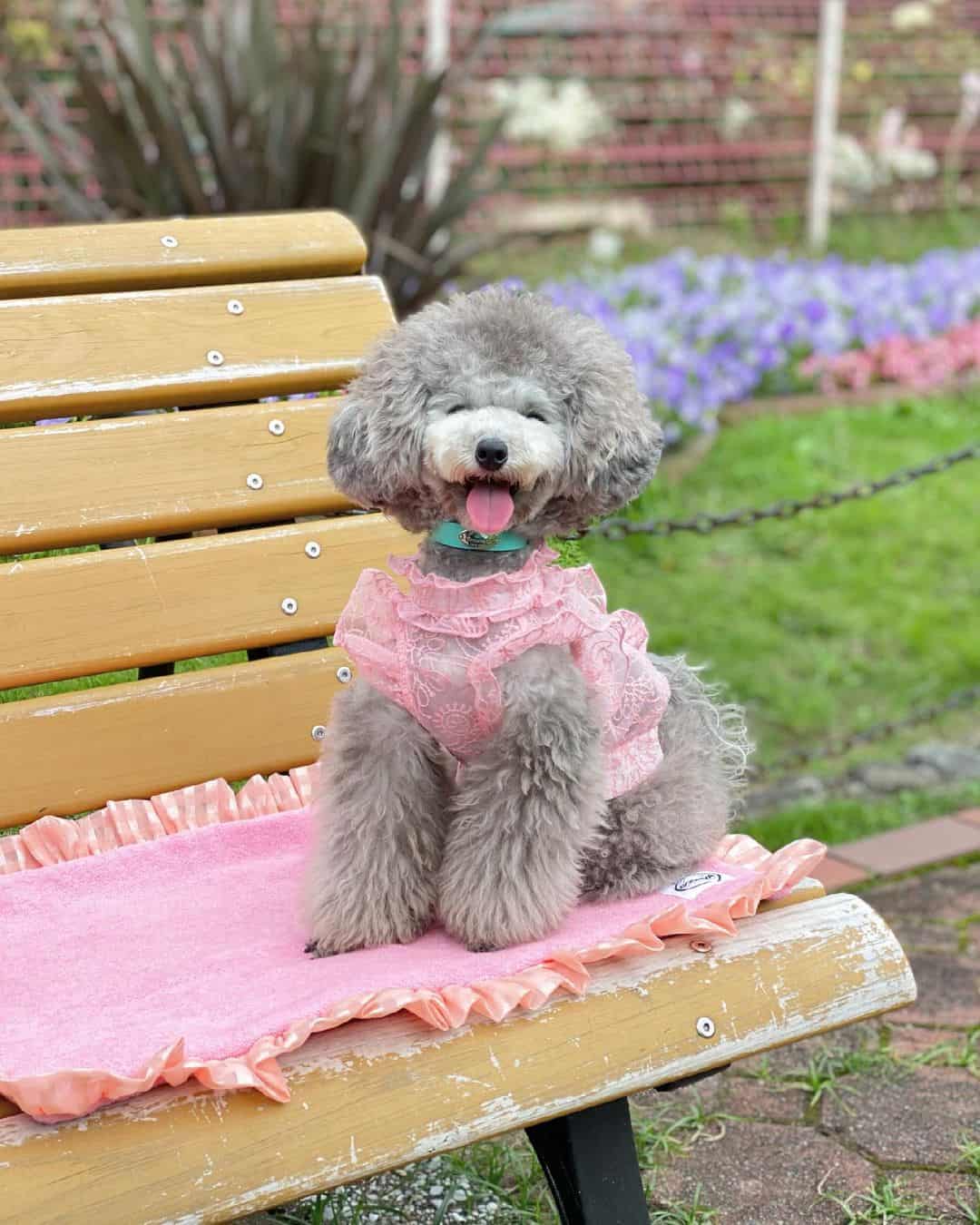
Photo from:@silverpoodle_amie
Yes, they are. Just like blues, the silver Poodle will be solid black when it is born but will begin to fade. It is a diluted version of the gene that provides a black coat. The difference with silvers is that their coats clear much more quickly, with the silvering showing on their paws and faces, usually starting at around six weeks of age.
This is another color that is difficult to breed, as it is a recessive gene. To guarantee that you get silver Poodle pups, you must have two silver parents.
The ideal silver Poodle color is pale platinum, but this is notoriously difficult to achieve, even for experienced breeders.
Do Poodle Puppies Change Color?
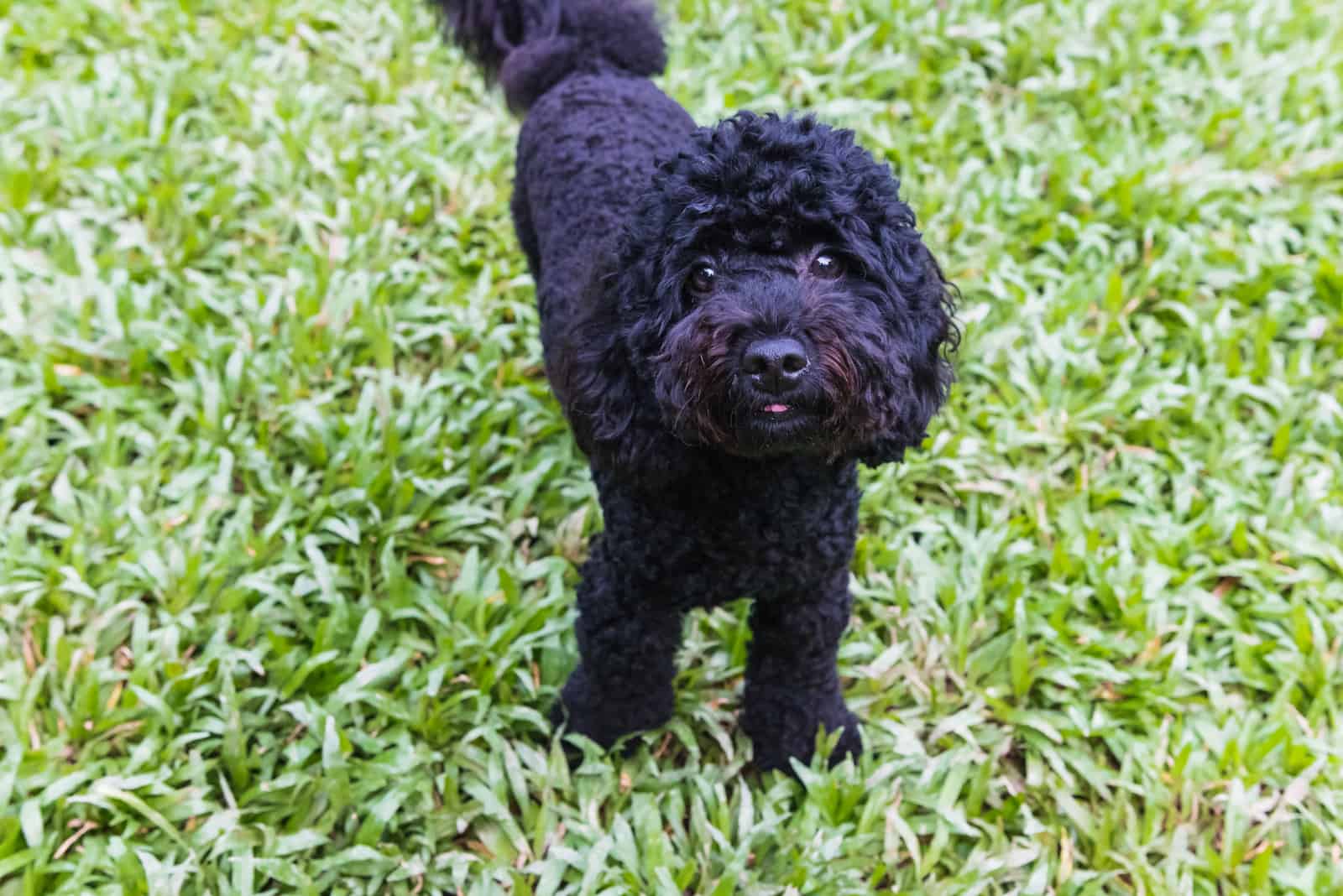
Most of them do! As we said above, clearing is common, with dark coats fading or lighter coats becoming darker.
This will depend on which genes are dominant or recessive.
True solid color Poodles with dominant genes won’t change color, but their coat may fade due to exposure to sunlight. The coat could also become dull with age, especially if it isn’t cared for.
It’s sometimes difficult to tell what color a Poodle will be when it matures, although reputable breeders are often able to determine this using their knowledge and experience. One clue is to look at the points (eyes, eyelids, lips, paw pads, and nose) to see what color they are and to check the color of the parents.
It is interesting that the AKC and other kennel clubs allow for such variety in coat colors, as many other breeds of dogs are strictly limited when it comes to color. It seems that the Poodle has been given special permission to be as colorful as possible.
This is good news, as it means that there is a wonderful range of beautiful Poodle colors to choose from.
Are Brown Poodles Born Black?
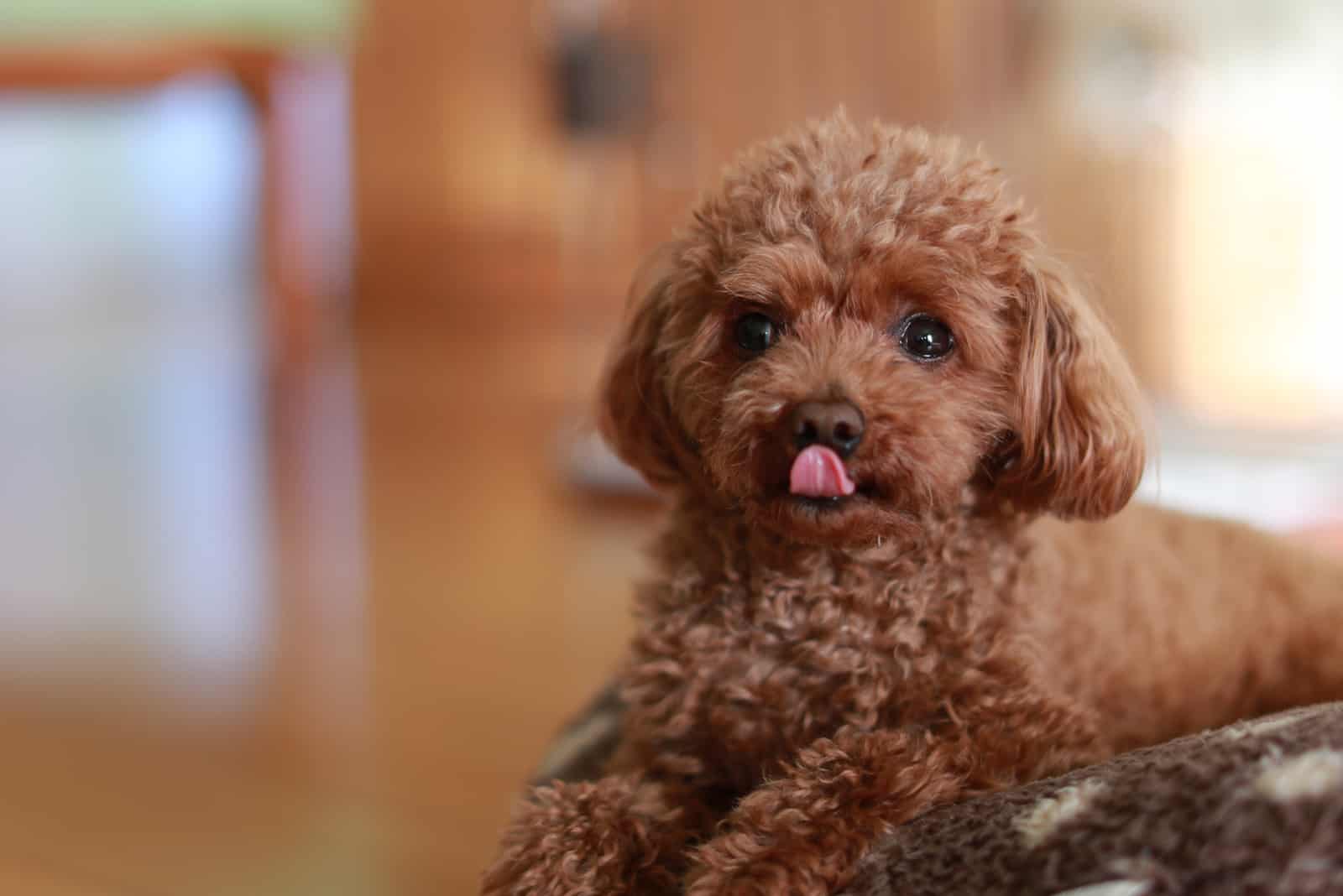
No, brown Poodles are usually born a deep, dark brown color. Admittedly, some will be so dark as to look black. However, they will often fade to a range of lighter colors, such as the cafe au lait, cream, or silver beige.
True brown Poodles will not fade and will remain a deep, rich brown color all their lives. They will have dark amber eyes and liver-colored points.
As with other colors, the tone will vary with each dog. You may have a chocolate-colored dog or one that is a much lighter brown. Once again, it’s this variety that makes them so special!
Blue Vs. Black Standard Poodle
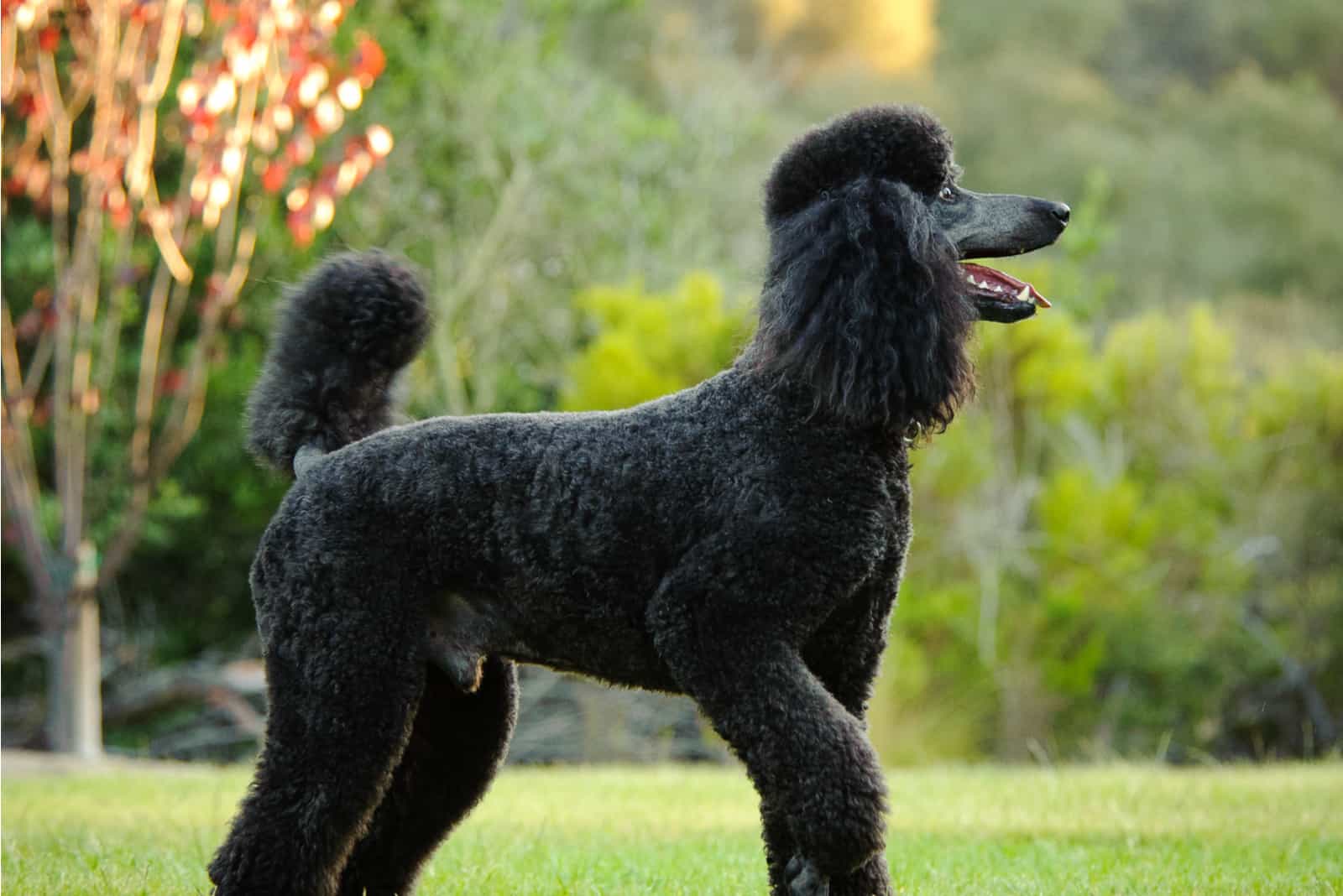
To be honest, there’s nothing to tell between the two, apart from their coat color. And when they are puppies, their coats are so similar that most people wouldn’t be able to see the difference!
Blue and silver Poodles both start life with a black coat that starts to fade. This usually starts when the pup is one year old but can take up to two years.
As for size, the Standard Poodle must be at least 15 inches at the shoulder. They will weigh between 45 and 70 pounds, which puts them in the medium to large category.
Like most other dogs, the males are larger than the females, and the coat color has no bearing on this.
Speaking of their coat, we should say a word or two about the fancy clipping styles. While they might seem a little over-the-top, and in some cases ridiculous, many of these styles reflect the dog’s past use. When they assisted hunters, they were expected to dive into cold water. Their furry coat was kept thicker around the areas that needed to be kept warm, while the shaven areas reduced the drag while the dog was swimming.
Many Poodle owners choose a different style these days, but that coat is still prized for its allergy-friendliness. Once again, the color doesn’t affect the hypoallergenic qualities.
So, whether it’s blue or black, your Standard Poodle will be the same in all other ways. It all comes down to personal preference.
Summing Up
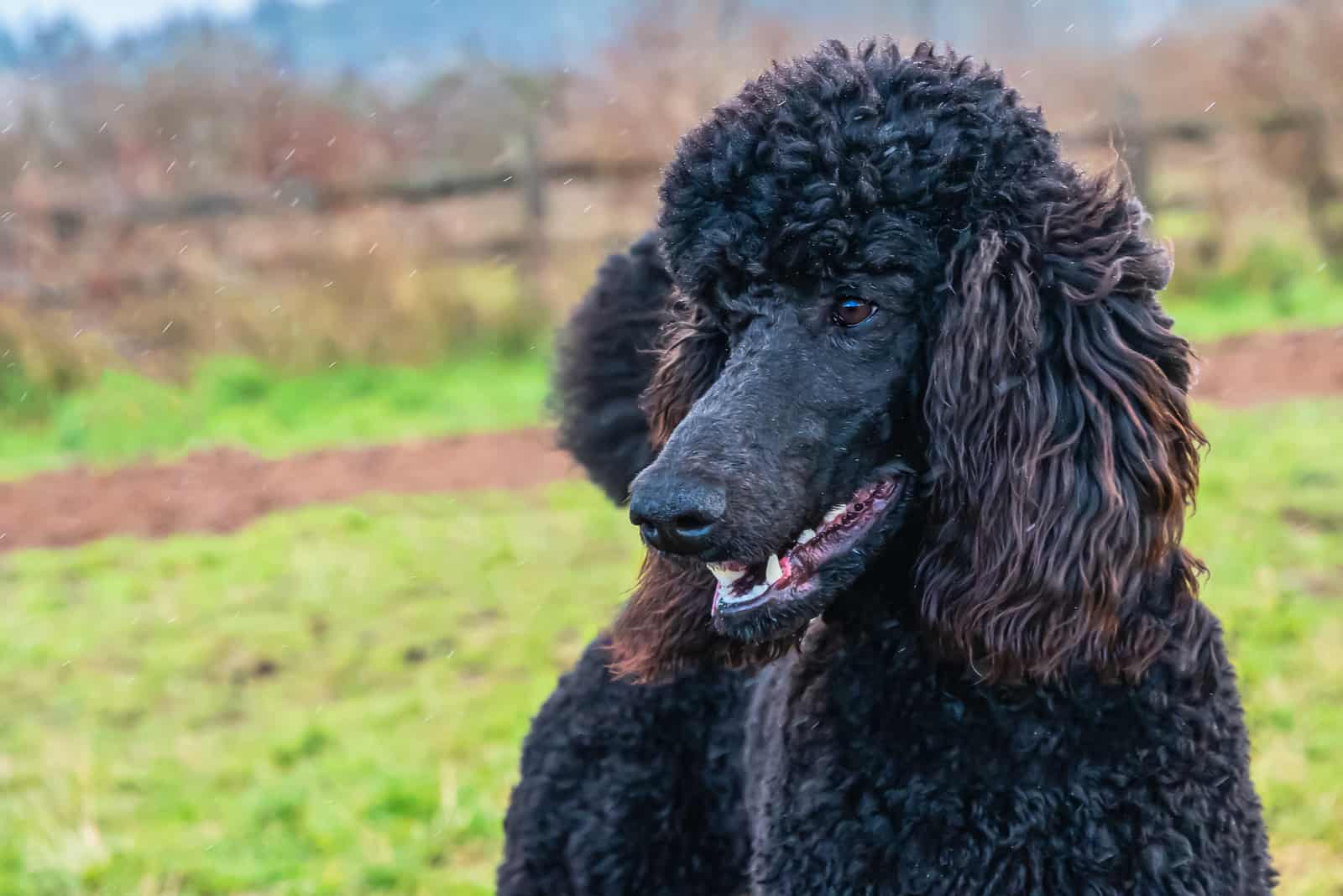
In modern times we have become more adventurous, and we expect more variety in our lives. And this extends to the colors, shapes, and sizes of our doggy friends! So, we have red, blue, apricot, silver, cream, and coffee-colored Poodles. We also have two-tone dogs, and we haven’t even mentioned phantom and tuxedo coloring! (The latter is fairly self-explanatory, as it’s a marking that makes the dog look like it’s wearing a tux, whereas the former is a set of markings similar to the parti, but which are more specific.)
Even so, we still love ‘solid’ colors, especially white and black.
In the beginning, we hinted that we would focus on the black Poodle, and we make no excuses for this as black dogs often experience unfair treatment in favor of lighter colors.
However, it has to be said that all Poodles are brilliant, whatever their color.
They are smart, loyal, fun, playful, obedient, and affectionate. They are good with kids and great for people with mild pet allergies.
So, if you are considering getting yourself a Poodle, you have a range of colors to choose from. Although, you might find it a challenge to find a red or an apricot one. You could get a silver, cream, or blue one, or even a cafe au lait.
You could settle for a plain old white Poodle, like most other people. Or you could get that lovely, inky-black dog with its beautiful dark eyes and shiny coat. Go on, let’s make black dog syndrome history!
Read Next: 8 Reputable Poodle Breeders In Colorado
